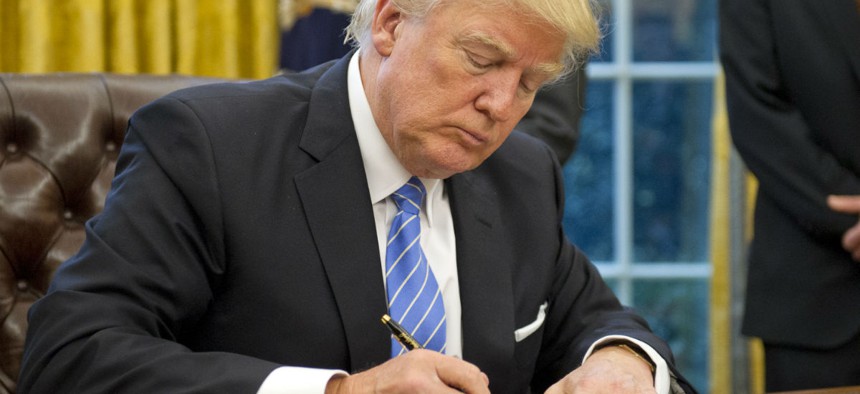90-Day Federal Hiring Freeze Would Impact 19K Jobs, Consultant Estimates
Deltek VP "pretty bullish" on contracting under Trump given new defense spending.
President Trump’s order for a 90-day governmentwide hiring freeze to reduce the federal workforce through attrition will impact about 19,000 jobs, a consulting firm estimates.
Kevin Plexico, vice president for research at Deltek, offered “back of the envelope” calculations in a Feb. 8 webinar to determine the overall number of jobs affected, concluding that in the short term the freeze “would not be very impactful.” Substantial portions of the staff at major defense and law enforcement agencies are exempt from the order Trump signed on Jan. 23, Plexico noted, and thus he subtracted Defense Department civilians (at 759,000 or 37 percent of the 2 million-plus overall federal civilian workforce); the Justice and Homeland Security departments (at 304,000 or 14.7 percent of the total workforce); and Veterans Affairs Department health workers (331,000 employees or 16 percent of the total) from the number of people potentially affected.
That leaves 673,000 employees vulnerable to the freeze, he said. With the attrition rate of 11.1 percent annually, or 0.9 percent monthly, Deltek calculated that attrition during the 90 days would leave 18,675 positions unfilled.
As Government Executive has reported, the exemptions to the freeze are more nuanced and don’t cover the entire Defense Department civilian staff or the entire Veterans Health Administration staff, for instance. There is also some uncertainty as to how the freeze is being implemented across agencies.
The key to determining the longer-term impact of Trump’s workforce policies, Plexico said, is to wait for the Office of Management and Budget and the Office of Personnel Management by April “to come up with [their required] plan to achieve cost savings by reducing federal employees.”
Contractors, “it’s a safe bet,” should look forward to Trump spending more on homeland security, cybersecurity and defense, the consultant said. “DoD has hit the low water mark and started moving in the direction of back up,” he added. And the spending caps under the 2011 Budget Control Act are now for the first time rising—though they’re still there, Plexico noted.
Based on which agencies depend the most on contractors, his firm figures that Homeland Security and Veterans Affairs have the highest volume of contract-transferable dollars, along with the coming multi-agency $9 billion information technology modernization fund. “The VA has support on a bipartisan basis, so there’s not too much headwind,” Plexico said.
Plexico analyzed the Heritage Foundation’s budget blueprint calling for $102 billion in discretionary cuts, which Trump is reportedly embracing. Using Congress’ appropriations categories, the accounts taking the biggest hits would be Interior and Environment (24.7 percent); Energy and Water 17 percent; Transportation and Housing and Urban Development (14 percent); and Labor, Health and Human Services and Education (11.5 percent.)
As for executive orders on regulations in such areas as climate change, Trump “seems to be following the list” he laid out in his campaign and 100-day plan, Plexico said. But the slow pace of filling second and third-tier agency slots, he added, presents challenges. “You can expect him to continue initiatives that are already approved and funded, but don’t expect new initiatives” until the key personnel are in place.








